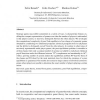Free Online Productivity Tools
i2Speak
i2Symbol
i2OCR
iTex2Img
iWeb2Print
iWeb2Shot
i2Type
iPdf2Split
iPdf2Merge
i2Bopomofo
i2Arabic
i2Style
i2Image
i2PDF
iLatex2Rtf
Sci2ools
STACS
2007
Springer
2007
Springer
Symmetries and the Complexity of Pure Nash Equilibrium
Strategic games may exhibit symmetries in a variety of ways. A characteristic feature, enabling the compact representation of games even when the number of players is unbounded, is that players cannot, or need not, distinguish between the other players. We investigate the computational complexity of pure Nash equilibria in four classes of symmetric games obtained by considering two additional properties: identical payoff functions for all players and the ability to distinguish oneself from the other players. In contrast to other types of succinctly representable multi-player games, the pure equilibrium problem is tractable in all four classes when only a constant number of actions is available to each player. Identical payoff functions make the difference between TC0-completeness and membership in AC0, while a growing number of actions renders the equilibrium problem NP-hard for three of the classes and PLS-hard for the most restricted class for which the existence of a pure equili...
Identical Payoff Functions | Pure Equilibrium | STACS 2007 | Symmetric Games | Theoretical Computer Science |
Related Content
| Added | 09 Jun 2010 |
| Updated | 09 Jun 2010 |
| Type | Conference |
| Year | 2007 |
| Where | STACS |
| Authors | Felix Brandt, Felix A. Fischer, Markus Holzer |
Comments (0)

